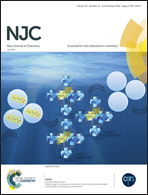Controllable synthesis of NiO/Ni3S2 hybrid arrays as efficient electrocatalysts for water splitting†
Abstract
It is significant to develop economically cheaper, more environmentally friendly bifunctional electrocatalysts for both water reduction reaction (WRR) and water oxidation reaction (WOR). In this paper, a NiO/Ni3S2 core–shell hybrid directly grown on nickel foam is constructed using a simple two-step hydrothermal and sulfuration method. When the NiO/Ni3S2/NF electrode is first tested as a catalyst, it reveals a high catalytic activity and durability for WOR. The smaller overpotential of only 270 mV obtained at 30 mA cm−2 is better than the benchmark of precious metal RuO2 materials (410 mV @ 30 mA cm−2), benefiting from the unique hierarchical structure of NiO/Ni3S2/NF with more active sites and fast electron transfer. Moreover, the NiO/Ni3S2/NF electrode also exhibits a fairly good WRR performance compared with the individual NiO/NF and NF electrodes, showing a smaller overpotential of only 130 mV at 10 mA cm−2. In addition to this, a very low cell voltage of 1.59 V is obtained at 10 mA cm−2 in 1.0 M KOH, when NiO/Ni3S2/NF is also tested as a bifunctional water splitting electrode. The experimental results indicate that the oxide/sulfide-based catalysts could serve as an ideal electrode candidate and bring the superiority of a synergistic strategy into full play, which offers a new idea toward the development of efficient and environmentally friendly water splitting electrochemical electrode materials.



 Please wait while we load your content...
Please wait while we load your content...